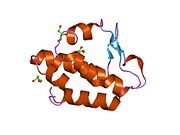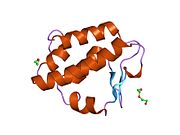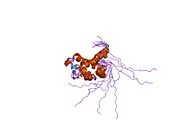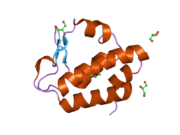NGLY1
| NGLY1 | |||||||||||||||||||||||||
|---|---|---|---|---|---|---|---|---|---|---|---|---|---|---|---|---|---|---|---|---|---|---|---|---|---|
 | |||||||||||||||||||||||||
| |||||||||||||||||||||||||
| Identifiers | |||||||||||||||||||||||||
| Aliases | NGLY1, CDG1V, PNG1, PNGase, CDDG, N-glycanase 1, PNG-1 | ||||||||||||||||||||||||
| External IDs | OMIM: 610661 MGI: 1913276 HomoloGene: 10117 GeneCards: NGLY1 | ||||||||||||||||||||||||
| |||||||||||||||||||||||||
| |||||||||||||||||||||||||
| |||||||||||||||||||||||||
| |||||||||||||||||||||||||
| Orthologs | |||||||||||||||||||||||||
| Species | Human | Mouse | |||||||||||||||||||||||
| Entrez | |||||||||||||||||||||||||
| Ensembl | |||||||||||||||||||||||||
| UniProt | |||||||||||||||||||||||||
| RefSeq (mRNA) | |||||||||||||||||||||||||
| RefSeq (protein) | |||||||||||||||||||||||||
| Location (UCSC) | Chr 3: 25.72 – 25.79 Mb | Chr 14: 16.25 – 16.31 Mb | |||||||||||||||||||||||
| PubMed search | [3] | [4] | |||||||||||||||||||||||
| Wikidata | |||||||||||||||||||||||||
| |||||||||||||||||||||||||
PNGase also known as N-glycanase 1 (EC 3.5.1.52) or peptide-N(4)-(N-acetyl-beta-glucosaminyl)asparagine amidase is an enzyme that in humans is encoded by the NGLY1 gene. PNGase is a de-N-glycosylating enzyme that removes N-linked or asparagine-linked glycans (N-glycans) from glycoproteins.[5][6][7] More specifically, NGLY1 catalyzes the hydrolysis of the amide bond between the innermost N-acetylglucosamine (GlcNAc) and an Asn residue on an N-glycoprotein, generating a de-N-glycosylated protein, in which the N-glycoylated Asn residue is converted to asp, and a 1-amino-GlcNAc-containing free oligosaccharide. Ammonia is then spontaneously released from the 1-amino GlcNAc at physiological pH (<8), giving rise to a free oligosaccharide with an N,N’-diacetylchitobiose structure at the reducing end.
Discovery[]
Occurrence of cytoplasmic PNGase activity in mammalian cells was first reported in cultured cells.[8] This enzyme differ from other “reagent” PNGases from almond (glycoamidase/PNGase A),[9] or bacteria (N-glycanase/PNGase F),[10] that is often used for structural/functional studies of N-glycans, in several enzymatic properties, including the requirement of a reducing reagent for activity and a neutral pH for optimal activity.[8][11][12]
The gene encoding the cytoplasmic PNGase was first identified in budding yeast, Saccharomyces cerevisiae and gene orthologues have since been found in wide variety of eukaryotes including mammals.[13] In terms of the tissue distribution of the mouse Ngly1 gene, enzyme activities as well as transcripts were detected in all tissues/organs examined.[12][14]
Structure[]
The catalytic residues of the cytoplasmic PNGase is known to reside in a domain called transglutaminase domain.[15][16] NGLY1, when compared with the yeast orthologues, possesses extended N-terminal and C-terminal sequences in addition to the transglutaminase domain. Among the additional domains found in NGLY1, the PUB (PNGase- and ubiquitin-related) domain was first identified through a bioinformatics analysis.[17][18] While it was initially hypothesized that it might serve as a protein-protein interaction domain,[17] experimental evidence supporting this hypothesis is now accumulating.[19][20][21] On the other hand, the C-terminal PAW domain (a domain present in PNGases and other worm proteins).[18] has now been shown to be involved in the binding of oligosaccharides to PNGase.[22]
In terms of the crystal structures of mouse Ngly1, a catalytic core domain,[23] a C-terminal domain including PAW domain[22] and an N-terminal domain including PUB domain.[24] have been obtained.
Function[]
Regarding the function of NGLY1, it has been shown that the enzyme is involved in the ER-associated degradation (ERAD), one of the ER quality control/homeostasis systems for newly synthesized glycoproteins.[25][26][27][28] The functional importance of NGLY1 in the ERAD process, however, is not clearly understood. It has also been suggested that NGLY1 is closely involved in MHC class I-mediated antigen presentation.[29][30][31] The Ngly1-mediated (glycosylated) Asn-to-Asp deamidation constitutes, together with other reactions such as transpeptidation, unconventional post-translational modifications for antigenic peptides that are presented by MHC class I molecules.[32]
NGLY1-binding proteins[]
Through yeast two-hybrid screening, it has been shown that NGLY1 proteins can bind to several proteins, mostly through the N-terminal domain including the PUB domain.[33] In vivo and in vitro interactions between NGLY1 and several ERAD-related proteins have been reported.[20][23][24][33][34][35][36][37][38] While the importance of those protein-protein interactions to NGLY1 functions remain to be clarified, it can be assumed that such interactions may be advantageous for an efficient ERAD process.[39]
Clinical significance[]
In 2012, NGLY1 deficiency, involving mutations in the NGLY1 gene locus was first identified through an exome analysis.[40] As of now, the clinical features of 11 patients have been reported.[41][42][43] One cerebral visual impairment (CVI) patient also had a mutation in NGLY1 gene.[44] The clinical effects include neuromotor impairment, intellectual disability, and neuropathy. It has also been associated with amyotrophic lateral sclerosis and Parkinson's disease.
Details of the mechanism responsible for the pathogenesis of the NGLY1-deficiency remains unknown, while the intracellular accumulation of N-GlcNAc proteins, due to the excess action of cytosolic endo-b-N-acetylglucosaminidase[45] to misfolded glycoproteins, in Ngly1-deficient cells has been hypothesized as a potential cause.[28]
NGLY1 deficiency has drawn attention in the public.[46][47][48][49]
Studies have been carried out to discover small-molecules that can bind to the transglutaminase domain of the protein to stabilize it as a potential therapeutic applications in the treatment of disorder caused by NGLY1 mutants.[50]
Notes[]
The 2015 version of this article was updated by an external expert under a dual publication model. The corresponding academic peer reviewed article was published in Gene and can be cited as: Tadashi Suzuki; Chengcheng Huang; Haruhiko Fujihira (20 November 2015). "The cytoplasmic peptide:N-glycanase (NGLY1) - Structure, expression and cellular functions". Gene. Gene Wiki Review Series. 577 (1): 1–7. doi:10.1016/J.GENE.2015.11.021. ISSN 0378-1119. PMC 4691572. PMID 26611529. Wikidata Q30274598. |
References[]
- ^ a b c GRCh38: Ensembl release 89: ENSG00000151092 - Ensembl, May 2017
- ^ a b c GRCm38: Ensembl release 89: ENSMUSG00000021785 - Ensembl, May 2017
- ^ "Human PubMed Reference:". National Center for Biotechnology Information, U.S. National Library of Medicine.
- ^ "Mouse PubMed Reference:". National Center for Biotechnology Information, U.S. National Library of Medicine.
- ^ Hirayama H, Hosomi A, Suzuki T (May 2015). "Physiological and molecular functions of the cytosolic peptide:N-glycanase". Seminars in Cell & Developmental Biology. 41: 110–20. doi:10.1016/j.semcdb.2014.11.009. PMID 25475175.
- ^ Suzuki T (Jan 2015). "The cytoplasmic peptide:N-glycanase (Ngly1)-basic science encounters a human genetic disorder". Journal of Biochemistry. 157 (1): 23–34. doi:10.1093/jb/mvu068. PMID 25398991.
- ^ Suzuki T, Huang C, Fujihira H (Jan 2016). "The cytoplasmic peptide:N-glycanase (NGLY1) - Structure, expression and cellular functions". Gene. 577 (1): 1–7. doi:10.1016/j.gene.2015.11.021. PMC 4691572. PMID 26611529.
- ^ a b Suzuki T, Seko A, Kitajima K, Inoue Y, Inoue S (Aug 1993). "Identification of peptide:N-glycanase activity in mammalian-derived cultured cells". Biochemical and Biophysical Research Communications. 194 (3): 1124–30. doi:10.1006/bbrc.1993.1938. PMID 8352768.
- ^ Takahashi N (Jun 1977). "Demonstration of a new amidase acting on glycopeptides". Biochemical and Biophysical Research Communications. 76 (4): 1194–201. doi:10.1016/0006-291x(77)90982-2. PMID 901470.
- ^ Plummer TH, Elder JH, Alexander S, Phelan AW, Tarentino AL (Sep 1984). "Demonstration of peptide:N-glycosidase F activity in endo-beta-N-acetylglucosaminidase F preparations". The Journal of Biological Chemistry. 259 (17): 10700–4. doi:10.1016/S0021-9258(18)90568-5. PMID 6206060.
- ^ Suzuki T, Seko A, Kitajima K, Inoue Y, Inoue S (Jul 1994). "Purification and enzymatic properties of peptide:N-glycanase from C3H mouse-derived L-929 fibroblast cells. Possible widespread occurrence of post-translational remodification of proteins by N-deglycosylation". The Journal of Biological Chemistry. 269 (26): 17611–8. doi:10.1016/S0021-9258(17)32485-7. PMID 8021270.
- ^ a b Kitajima K, Suzuki T, Kouchi Z, Inoue S, Inoue Y (Jun 1995). "Identification and distribution of peptide:N-glycanase (PNGase) in mouse organs". Archives of Biochemistry and Biophysics. 319 (2): 393–401. doi:10.1006/abbi.1995.1309. PMID 7786020.
- ^ Suzuki T, Park H, Hollingsworth NM, Sternglanz R, Lennarz WJ (May 2000). "PNG1, a yeast gene encoding a highly conserved peptide:N-glycanase". The Journal of Cell Biology. 149 (5): 1039–52. doi:10.1083/jcb.149.5.1039. PMC 2174826. PMID 10831608.
- ^ Suzuki T, Kwofie MA, Lennarz WJ (May 2003). "Ngly1, a mouse gene encoding a deglycosylating enzyme implicated in proteasomal degradation: expression, genomic organization, and chromosomal mapping". Biochemical and Biophysical Research Communications. 304 (2): 326–32. doi:10.1016/s0006-291x(03)00600-4. PMID 12711318.
- ^ Makarova KS, Aravind L, Koonin EV (Aug 1999). "A superfamily of archaeal, bacterial, and eukaryotic proteins homologous to animal transglutaminases". Protein Science. 8 (8): 1714–9. doi:10.1110/ps.8.8.1714. PMC 2144420. PMID 10452618.
- ^ Katiyar S, Suzuki T, Balgobin BJ, Lennarz WJ (Apr 2002). "Site-directed mutagenesis study of yeast peptide:N-glycanase. Insight into the reaction mechanism of deglycosylation". The Journal of Biological Chemistry. 277 (15): 12953–9. doi:10.1074/jbc.M111383200. PMID 11812789.
- ^ a b Suzuki T, Park H, Till EA, Lennarz WJ (Oct 2001). "The PUB domain: a putative protein-protein interaction domain implicated in the ubiquitin-proteasome pathway". Biochemical and Biophysical Research Communications. 287 (5): 1083–7. doi:10.1006/bbrc.2001.5688. PMID 11587532.
- ^ a b Doerks T, Copley RR, Schultz J, Ponting CP, Bork P (Jan 2002). "Systematic identification of novel protein domain families associated with nuclear functions". Genome Research. 12 (1): 47–56. doi:10.1101/gr.203201. PMC 155265. PMID 11779830.
- ^ Allen MD, Buchberger A, Bycroft M (Sep 2006). "The PUB domain functions as a p97 binding module in human peptide N-glycanase". The Journal of Biological Chemistry. 281 (35): 25502–8. doi:10.1074/jbc.M601173200. PMID 16807242.
- ^ a b Kamiya Y, Uekusa Y, Sumiyoshi A, Sasakawa H, Hirao T, Suzuki T, Kato K (Apr 2012). "NMR characterization of the interaction between the PUB domain of peptide:N-glycanase and ubiquitin-like domain of HR23". FEBS Letters. 586 (8): 1141–6. doi:10.1016/j.febslet.2012.03.027. PMID 22575648. S2CID 23573555.
- ^ Schaeffer V, Akutsu M, Olma MH, Gomes LC, Kawasaki M, Dikic I (May 2014). "Binding of OTULIN to the PUB domain of HOIP controls NF-κB signaling". Molecular Cell. 54 (3): 349–61. doi:10.1016/j.molcel.2014.03.016. PMID 24726327.
- ^ a b Zhou X, Zhao G, Truglio JJ, Wang L, Li G, Lennarz WJ, Schindelin H (Nov 2006). "Structural and biochemical studies of the C-terminal domain of mouse peptide-N-glycanase identify it as a mannose-binding module". Proceedings of the National Academy of Sciences of the United States of America. 103 (46): 17214–9. Bibcode:2006PNAS..10317214Z. doi:10.1073/pnas.0602954103. PMC 1859912. PMID 17088551.
- ^ a b Zhao G, Zhou X, Wang L, Li G, Kisker C, Lennarz WJ, Schindelin H (May 2006). "Structure of the mouse peptide N-glycanase-HR23 complex suggests co-evolution of the endoplasmic reticulum-associated degradation and DNA repair pathways". The Journal of Biological Chemistry. 281 (19): 13751–61. doi:10.1074/jbc.M600137200. PMID 16500903.
- ^ a b Zhao G, Zhou X, Wang L, Li G, Schindelin H, Lennarz WJ (May 2007). "Studies on peptide:N-glycanase-p97 interaction suggest that p97 phosphorylation modulates endoplasmic reticulum-associated degradation". Proceedings of the National Academy of Sciences of the United States of America. 104 (21): 8785–90. Bibcode:2007PNAS..104.8785Z. doi:10.1073/pnas.0702966104. PMC 1885580. PMID 17496150.
- ^ Wiertz EJ, Jones TR, Sun L, Bogyo M, Geuze HJ, Ploegh HL (Mar 1996). "The human cytomegalovirus US11 gene product dislocates MHC class I heavy chains from the endoplasmic reticulum to the cytosol". Cell. 84 (5): 769–79. doi:10.1016/s0092-8674(00)81054-5. PMID 8625414. S2CID 5122267.
- ^ Hirsch C, Blom D, Ploegh HL (Mar 2003). "A role for N-glycanase in the cytosolic turnover of glycoproteins". The EMBO Journal. 22 (5): 1036–46. doi:10.1093/emboj/cdg107. PMC 150340. PMID 12606569.
- ^ Grotzke JE, Lu Q, Cresswell P (Feb 2013). "Deglycosylation-dependent fluorescent proteins provide unique tools for the study of ER-associated degradation". Proceedings of the National Academy of Sciences of the United States of America. 110 (9): 3393–8. Bibcode:2013PNAS..110.3393G. doi:10.1073/pnas.1300328110. PMC 3587246. PMID 23401531.
- ^ a b Huang C, Harada Y, Hosomi A, Masahara-Negishi Y, Seino J, Fujihira H, Funakoshi Y, Suzuki T, Dohmae N, Suzuki T (Feb 2015). "Endo-β-N-acetylglucosaminidase forms N-GlcNAc protein aggregates during ER-associated degradation in Ngly1-defective cells". Proceedings of the National Academy of Sciences of the United States of America. 112 (5): 1398–403. Bibcode:2015PNAS..112.1398H. doi:10.1073/pnas.1414593112. PMC 4321286. PMID 25605922.
- ^ Skipper JC, Hendrickson RC, Gulden PH, Brichard V, Van Pel A, Chen Y, Shabanowitz J, Wolfel T, Slingluff CL, Boon T, Hunt DF, Engelhard VH (Feb 1996). "An HLA-A2-restricted tyrosinase antigen on melanoma cells results from posttranslational modification and suggests a novel pathway for processing of membrane proteins". The Journal of Experimental Medicine. 183 (2): 527–34. doi:10.1084/jem.183.2.527. PMC 2192446. PMID 8627164.
- ^ Altrich-VanLith ML, Ostankovitch M, Polefrone JM, Mosse CA, Shabanowitz J, Hunt DF, Engelhard VH (Oct 2006). "Processing of a class I-restricted epitope from tyrosinase requires peptide N-glycanase and the cooperative action of endoplasmic reticulum aminopeptidase 1 and cytosolic proteases". Journal of Immunology. 177 (8): 5440–50. doi:10.4049/jimmunol.177.8.5440. PMID 17015730.
- ^ Kario E, Tirosh B, Ploegh HL, Navon A (Jan 2008). "N-linked glycosylation does not impair proteasomal degradation but affects class I major histocompatibility complex presentation". The Journal of Biological Chemistry. 283 (1): 244–54. doi:10.1074/jbc.M706237200. PMID 17951257.
- ^ Dalet A, Robbins PF, Stroobant V, Vigneron N, Li YF, El-Gamil M, Hanada K, Yang JC, Rosenberg SA, Van den Eynde BJ (Jul 2011). "An antigenic peptide produced by reverse splicing and double asparagine deamidation". Proceedings of the National Academy of Sciences of the United States of America. 108 (29): E323–31. Bibcode:2011PNAS..108E.323D. doi:10.1073/pnas.1101892108. PMC 3142003. PMID 21670269.
- ^ a b Park H, Suzuki T, Lennarz WJ (Sep 2001). "Identification of proteins that interact with mammalian peptide:N-glycanase and implicate this hydrolase in the proteasome-dependent pathway for protein degradation". Proceedings of the National Academy of Sciences of the United States of America. 98 (20): 11163–8. Bibcode:2001PNAS...9811163P. doi:10.1073/pnas.201393498. PMC 58701. PMID 11562482.
- ^ McNeill H, Knebel A, Arthur JS, Cuenda A, Cohen P (Dec 2004). "A novel UBA and UBX domain protein that binds polyubiquitin and VCP and is a substrate for SAPKs". The Biochemical Journal. 384 (Pt 2): 391–400. doi:10.1042/BJ20041498. PMC 1134123. PMID 15362974.
- ^ Katiyar S, Li G, Lennarz WJ (Sep 2004). "A complex between peptide:N-glycanase and two proteasome-linked proteins suggests a mechanism for the degradation of misfolded glycoproteins". Proceedings of the National Academy of Sciences of the United States of America. 101 (38): 13774–9. Bibcode:2004PNAS..10113774K. doi:10.1073/pnas.0405663101. PMC 518832. PMID 15358861.
- ^ Katiyar S, Joshi S, Lennarz WJ (Oct 2005). "The retrotranslocation protein Derlin-1 binds peptide:N-glycanase to the endoplasmic reticulum". Molecular Biology of the Cell. 16 (10): 4584–94. doi:10.1091/mbc.E05-04-0345. PMC 1237066. PMID 16055502.
- ^ Li G, Zhou X, Zhao G, Schindelin H, Lennarz WJ (Nov 2005). "Multiple modes of interaction of the deglycosylation enzyme, mouse peptide N-glycanase, with the proteasome". Proceedings of the National Academy of Sciences of the United States of America. 102 (44): 15809–14. Bibcode:2005PNAS..10215809L. doi:10.1073/pnas.0507155102. PMC 1276080. PMID 16249333.
- ^ Li G, Zhao G, Zhou X, Schindelin H, Lennarz WJ (May 2006). "The AAA ATPase p97 links peptide N-glycanase to the endoplasmic reticulum-associated E3 ligase autocrine motility factor receptor". Proceedings of the National Academy of Sciences of the United States of America. 103 (22): 8348–53. Bibcode:2006PNAS..103.8348L. doi:10.1073/pnas.0602747103. PMC 1482497. PMID 16709668.
- ^ Suzuki T, Lennarz WJ (Feb 2003). "Hypothesis: a glycoprotein-degradation complex formed by protein-protein interaction involves cytoplasmic peptide:N-glycanase". Biochemical and Biophysical Research Communications. 302 (1): 1–5. doi:10.1016/s0006-291x(03)00052-4. PMID 12593838.
- ^ Need AC, Shashi V, Hitomi Y, Schoch K, Shianna KV, McDonald MT, Meisler MH, Goldstein DB (Jun 2012). "Clinical application of exome sequencing in undiagnosed genetic conditions". Journal of Medical Genetics. 49 (6): 353–61. doi:10.1136/jmedgenet-2012-100819. PMC 3375064. PMID 22581936.
- ^ Enns GM, Shashi V, Bainbridge M, Gambello MJ, Zahir FR, Bast T, Crimian R, Schoch K, Platt J, Cox R, Bernstein JA, Scavina M, Walter RS, Bibb A, Jones M, Hegde M, Graham BH, Need AC, Oviedo A, Schaaf CP, Boyle S, Butte AJ, Chen R, Clark MJ, Haraksingh R, Cowan TM, He P, Langlois S, Zoghbi HY, Snyder M, Gibbs RA, Freeze HH, Goldstein DB (Oct 2014). "Mutations in NGLY1 cause an inherited disorder of the endoplasmic reticulum-associated degradation pathway". Genetics in Medicine. 16 (10): 751–8. doi:10.1038/gim.2014.22. PMC 4243708. PMID 24651605.
- ^ Caglayan AO, Comu S, Baranoski JF, Parman Y, Kaymakçalan H, Akgumus GT, Caglar C, Dolen D, Erson-Omay EZ, Harmanci AS, Mishra-Gorur K, Freeze HH, Yasuno K, Bilguvar K, Gunel M (Jan 2015). "NGLY1 mutation causes neuromotor impairment, intellectual disability, and neuropathy". European Journal of Medical Genetics. 58 (1): 39–43. doi:10.1016/j.ejmg.2014.08.008. PMC 4804755. PMID 25220016.
- ^ Heeley J, Shinawi M (Apr 2015). "Multi-systemic involvement in NGLY1-related disorder caused by two novel mutations". American Journal of Medical Genetics Part A. 167A (4): 816–20. doi:10.1002/ajmg.a.36889. PMID 25707956. S2CID 7959186.
- ^ Bosch DG, Boonstra FN, de Leeuw N, Pfundt R, Nillesen WM, de Ligt J, Gilissen C, Jhangiani S, Lupski JR, Cremers FP, de Vries BB (Sep 2015). "Novel genetic causes for cerebral visual impairment". European Journal of Human Genetics. 24 (5): 660–5. doi:10.1038/ejhg.2015.186. PMC 4930090. PMID 26350515.
- ^ Suzuki T, Yano K, Sugimoto S, Kitajima K, Lennarz WJ, Inoue S, Inoue Y, Emori Y (Jul 2002). "Endo-beta-N-acetylglucosaminidase, an enzyme involved in processing of free oligosaccharides in the cytosol". Proceedings of the National Academy of Sciences of the United States of America. 99 (15): 9691–6. Bibcode:2002PNAS...99.9691S. doi:10.1073/pnas.152333599. PMC 124980. PMID 12114544.
- ^ "Kids who don't cry: New genetic disorder discovered".
- ^ "One of a Kind". 14 July 2014.
- ^ "Hunting down my son's killer".
- ^ Might M, Wilsey M (Oct 2014). "The shifting model in clinical diagnostics: how next-generation sequencing and families are altering the way rare diseases are discovered, studied, and treated". Genetics in Medicine. 16 (10): 736–7. doi:10.1038/gim.2014.23. PMID 24651604. S2CID 27270375.
- ^ Srinivasan B, Zhou H, Mitra S, Skolnick J (October 2016). "Novel small molecule binders of human N-glycanase 1, a key player in the endoplasmic reticulum associated degradation pathway". Bioorganic & Medicinal Chemistry. 24 (19): 4750–4758. doi:10.1016/j.bmc.2016.08.019. PMC 5015769. PMID 27567076.
This article incorporates text from the United States National Library of Medicine, which is in the public domain.
- Genes on human chromosome 3
- Wikipedia articles with corresponding academic peer reviewed articles
- Wikipedia articles with corresponding articles published in Gene









